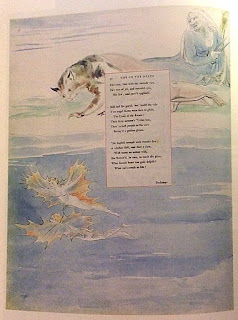The Private Memoirs and Confessions of a Justified Sinner
James Hogg
(Novel, first published 1824)
Catchy title, huh?
I suspect this book is one of those whose title is probably its worst
enemy. What it sounds like you’re going
to get is a lengthy biographical account of a religious devotee. What you actually get is a weird little story
of doppelgangers and devilry, in which murder and mayhem abound, and where two
women finally turn detective to uncover the truth.
It begins, somewhat unconventionally, with a
wedding scene in which a disgruntled bride is disgusted with her new husband’s
dissipated partying, but quickly takes up the story of their two sons (well at
least, there is some scope for debate about the parentage of one of the boys…
but I won’t spoil it for you!). The
important thing to know before reading this book is that the ‘Justified Sinner’
of the title refers to an offshoot of Christianity called Antinomianism which
adopts the belief that ‘Christians are by grace set
free from the need to observe any moral law’ (The Concise Oxford Dictionary of the
Christian Church, ‘antinomianism’ definition). More simply put, this system states that a
person can only gain a place in heaven through faith and the grace of God, and
not by earning it through good deeds.
What James Hogg does in his book is to explore a bigoted, extremist
version of this idea, in which one man comes to believe that, no matter what
crimes he commits, it cannot be morally wrong because he believes he is one of
God’s chosen people.
Underlying this is a brilliantly subtle, and
typically eighteenth-century, conflict of supernatural vs scientific
explanation. One of my university tutors
argued that, despite appearances, it is possible to provide a rational
explanation for everything that occurs in the text... but then there are others
(myself included) who simply cannot believe that there is not (quite literally)
some devilry at work…
One other thing I should mention, when it says ‘Editor’s
Narrative’ at the beginning, this is not some tedious explanation of abstract
editorial practice, it is actually the start of the story. As a way of giving the tale an enhanced
realism, Hogg creates the character of an editor into whose hands have come the
interesting documents in which the story continues. Kind of a way of writing himself into his own
story; neat, eh?
Set in Scotland, much of the action of the
narrative occurs in Edinburgh, and as I’ve just got back from a brief visit
there I couldn’t resist including a photo of Arthur’s Seat (the scene of an important
encounter in this novel, but as I don’t want to give away any spoilers I had
better say no more…)
With its emphasis on religious zealotry and the
tragic absurdities to which this can lead, The
Private Memoirs and Confessions of a Justified Sinner is actually an
extremely modern narrative, and a truly absorbing read. Think Heathcliff in Wuthering Heights is an intriguing character? Just wait until you meet the elusive
Gil-Martin…
Happy reading! As always, feel free to ask questions in comments!
You can
find this book:
Oxford World Classics edition: http://ukcatalogue.oup.com/product/9780199217953.do(always hugely recommended: these offer just the right balance of historical information to understand the story without intruding on the text too much!)
Edinburgh University Press edition: http://www.euppublishing.com/book/9780748663156
(a detailed scholarly edition)
Wordsworth Classics edition: http://www.amazon.co.uk/Private-Confessions-Justified-Wordsworth-Classics/dp/1853261882
(an affordable edition, with some explanatory
notes; apologies for the commercial bias of referencing Amazon here, this
edition is available in various other shops)
All these editions have various quantities of
annotation, a useful tool when reading texts this old, and something that I
hope to discuss further in future blogposts.
Don’t worry, though, what are known as ‘scholarly editions’ don’t have
to cost the earth: check out sites such as Ebay, etc. for second hand copies,
as these are often readily available at very economical rates! Free versions may be available for e-readers,
though it should be remembered that such texts have not always been prepared
carefully for publication. I cannot
overemphasise the importance of the helpful little notes that a publisher like
Penguin or Oxford World Classics would include in illuminating obscure or
archaic references!
If you want
to know more about James Hogg:
Wikipedia: https://en.wikipedia.org/wiki/James_Hogg(a useful starting point)
Interesting BBC article: http://www.bbc.co.uk/programmes/profiles/29mbnSxdmTg99TpfkcHpRtm/james-hogg
(includes an extensive reading list for those
thirsting to know more!)
The James Hogg Society blog:
(contains lots of interesting info)
The
quotation in this blogpost is from:
E.A. Livingstone, (ed.), The Concise Oxford Dictionary of the Christian Church. Oxford: Oxford University Press, 2006. Oxford Reference, 2006. Online version [accessed 15 June 2015]


